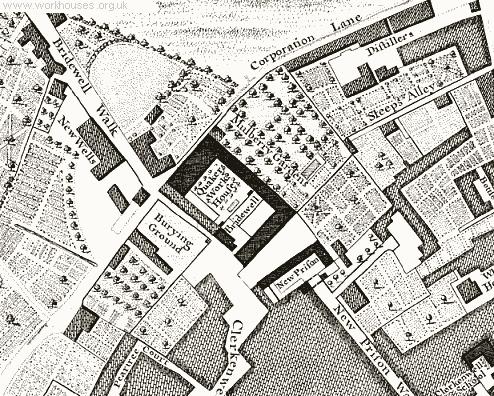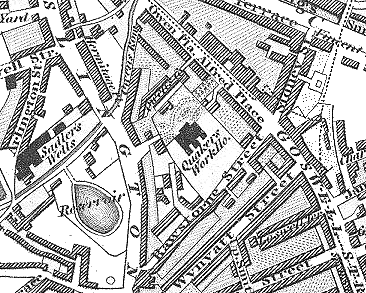The Quaker Workhouse at Clerkenwell, London
In 1680, the Society of Friends, better known as the Quakers, set up a scheme in London in which stocks of flax were purchased for supplying the Quaker poor to spin-up at home or in prison. This project had as its treasurer John Bellers who later developed plans for a 'College of Industry' — a co-operative, self-sufficient, humanitarian community where up to two hundred labourers and a hundred of the impotent poor lived and worked together. There would be an emphasis on education and training, although this would be done more by object-lessons than by theory, and more by practice and experience than by rote learning. The College was planned to consist of four wings: one for married people, one for single young men and boys, one for single women and girls, and one for sick and invalid members. The College would also have a library and a 'physick-garden', laboratories for the preparation of medicines.
Although Bellers' utopian plans were never implemented, their influence can be seen in two subsequent establishments set up by the Quakers. The first, a workhouse at Bristol founded in 1696, is described on a separate page. The second, was a workhouse and school opened in 1702 at Clerkenwell. The building, which had served as the Middlesex County workhouse until 1672, formed three sides of a square; at its southern hand there was a bridewell dating from 1616. The location of the Clerkenwell workhouse is shown on the 1746 map below:

The Quaker Workhouse at Clerkenwell, 1746.
The workhouse was intended to house fifty-six 'decayed Friends and Orphans'. The elderly occupied one section of the house, with the children in another where they were employed in spinning mop-yarn. The girls also made and mended the inmates clothing, while the boys learnt to read, write and cast accounts. Cold baths were on offer to the inmates 'for their Health or Cleanliness'. The inmates brewed their own beer, and the children helped in preparing all the food. The weekly menu was as follows:
| Breakfast and Supper | Dinner | |
| 1st. Day | 4 Oz. of Bread 2 Oz. of Cheese 1 Oz. of Butter 1 Pint of Beer |
8 Oz. of Roast Meat without Bones. 4 Oz. of Bread 1 Pint of Beer |
| 2nd. Day | The same as the 1st. Day | 1 Pint of Milk 4 Oz.of Bread, and Beer if desired |
| 3rd. Day | The same | 8 Oz. of Boyl'd Meat without Bones. 4 Oz. of Bread, and 1 Pint of Beer |
| 4th. Day | 1 Pint of Broth 4 Oz. of Bread 1 Pint of Beer |
1 Pint of Frumety or Rice-Milk 4 Oz. of Bread, and 1 Pint of Beer |
| 5th. Day | The same as the 1st. Day | 8 Oz. of Boyl'd Meat without Bones.
4 Oz. of Bread 1 Pint of Beer |
| 6th. Day | The same as the 4th. Day | 1 Pound of Plumb or plain Pudding 1 Pint of Beer |
| 7th. Day | The same as the 1st. Day | 1 Pint of Milk Porridge,
4 Oz. of Bread, or 1 Pint of Pease-Pottage 1 Oz.Butter, and 1 Pint of Beer |
Children received the same but with reduced portions. The meals could also be varied when foods such as peas, beans, mackerel, herring, salt fish, etc. were in season.
The Workhouse Steward's diary from 1711-37 survives (Hitchcock, 1987). It offers a valuable insight into the operation of an early 18th century workhouse, as the following extract shows:
And now we have in the house about 28 [boys] and 17 girls, 11 men and 11 women. Two of them, a man and the other a woman, are lame and use crutches, and another woman friend is blind. The rest are mostly aged and weak, of whom several have kept their beds pretty much this last winter and three of the women friends who are usually sent into the house now are not of ability to be nurses as formerly they were. And our children are generally now small and several of them have been sickly and weak most part of last winter. One girl in particular was ill near six months, who had been sorely afflicted with convulsion fits to such a degree as has made her incapable of walking but by use of crutches; and she had a fire in her chamber constantly for several weeks and one to sit up or to be with her in her chamber all the time, the fits being often upon her and suddenly taken.
In the year 1714 the committee gave leave by minute to hire a nurse into the house as occasion required. But upon enquiry found a nurse could not be had under 4s. per week & victuals and that if 5 or 6 of the family should be unwell at the same time a nurse would scarcely be willing to tend the sick in several places in the house, especially when they sit up all night. And if we have not suitable assistants who may be helpful from one place to another in the house as occasion requires, the sick & aged cannot have that due tendance they ought to have. These things, with how little work nurses do in the house and some of them wasteful withal, being considered made us very unwilling to take a nurse in the house. But in winter season it has been very hard for my wife and the servants, especially the servant maid who spent most of her time in that service and tending the children.
She has lately left this place alleging the hardness of her service here had impaired her health. She was a very good servant and would willingly have stayed with us, but could not go through the business. She used to mend the children's woollen clothes, which are generally but very ordinary and if they were put out to mend would cost more than they are worth and might make the monthly meetings very uneasy. She makes their beds and cleans their rooms, takes in and gives out their woollen and linen clothes, combs their heads, and dresses their sore hands and feet in the winter season, having many of them sores, which business alone takes several hours every day as may reasonably be supposed where there are so many small children and 17 or 18 of them are girls, who are more trouble than boys. Which with the weak and aged and when sickness, lameness happens in the family we find pretty much uneasiness, the sick and weak complaining for want of tendance on the one hand and the servants, not being able to do the business, complain on the other hand, so that we find a real necessity for another maid servant, which my wife can better make appear to any of the committee who will please to inspect into the business of each servant [than] I can demonstrate in writing. And it being expected my wife should see the provision &c orderly managed and seasonably distributed with frugality towards the house and a sufficiency towards the poor, and also to see the aged and weak have no just cause to complain for assistance, these particulars cannot be answered with ease to the family's satisfaction, to the helpless, and we who have the direction of the affairs under you, without the assistance herein mentioned. May 1718.
[Extract by kind permission of Tim Hitchcock]
The school moved to Islington in 1786 and the buildings suffered neglect — in 1803 they were described as 'ruins' although some parts were still let out to poor occupants at very low rents. The buildings were later demolished although are still shown on the 1828 map below.

The Quaker Workhouse site at Clerkenwell, 1828.
The site was later occupied by a series of prisons including the Middlesex House of Detention from 1845 to 1877. A new London Schools Board Secondary School was erected on the site in 1893 with the old prison dungeons retained as school staff rooms. In more recent times, these were opened up as a tourist attraction as the 'House of Detention 1616-1990 — London's Underground Prison';.
Records
Note: many repositories impose a closure period of up to 100 years for records identifying individuals. Before travelling a long distance, always check that the records you want to consult will be available.
Essex Record Office, Wharf Road Chelmsford CM2 6YT.- Holdings include original of Richard Hutton's Complaints Book (1711-37).
Bibliography
- Hitchcock, Tim. Richard Hutton's Complaints Book. The Notebook of the Steward of the Quaker Workhouse at Clerkenwell, 1711-1737. 1987, London Record Society.
Links
- None.
Unless otherwise indicated, this page () is copyright Peter Higginbotham. Contents may not be reproduced without permission.


